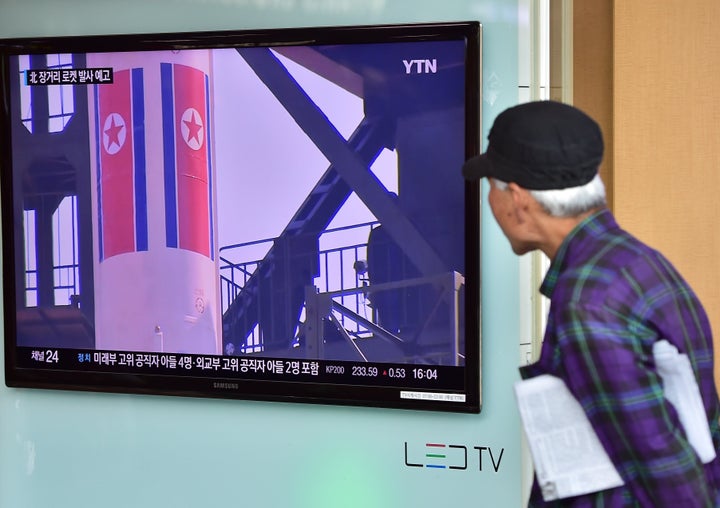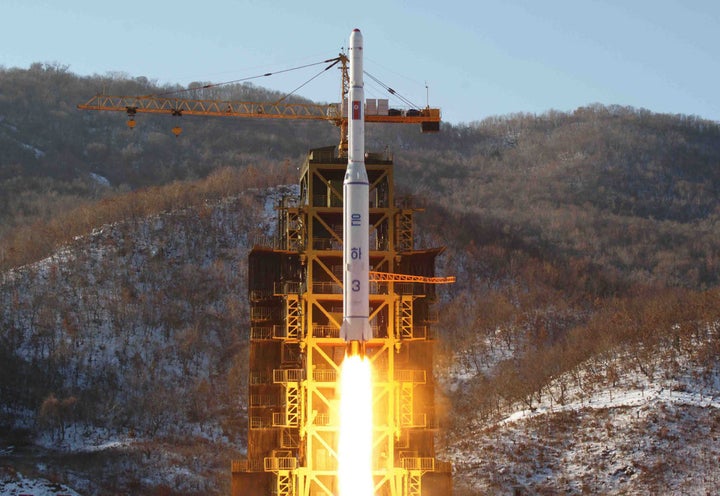
Every week, The WorldPost asks an expert to shed light on a topic driving headlines around the world. Today, we speak with Chad O’Carroll, founder of NK News, an independent news and analysis site on North Korea.
North Korean officials sent a defiant message to the world over their nuclear and missile programs this week, as the reclusive regime gears up to celebrate the ruling party’s 70th anniversary.
The head of Pyongyang’s space agency said on Monday it was preparing to send a new earth observation satellite into space on a long-range rocket. The U.S. has warned this would violate United Nations resolutions against Pyongyang conducting ballistic missile tests, because of the similarity of the technology involved. Meanwhile, analysts and South Korean officials are skeptical of the announcement, saying there is little sign that Pyongyang is readying a satellite launch.
A day later, the director of North Korea’s Atomic Energy Institute announced that the country’s main Nyongbyon nuclear complex was fully operational again and reiterated threats to use nuclear weapons against the U.S. The complex was closed in 2007 during six-party talks with the U.S., China, Russia, Japan and South Korea. But the talks collapsed, and North Korea said in 2013 that it would resume nuclear enrichment. Tuesday’s announcement accords with recent analysis by 38 North, a project of the U.S.-Korea Institute at John Hopkins University, which concluded, based on satellite imagery, that North Korea is “expanding its capacity to mine and mill natural uranium.”
The WorldPost spoke to Chad O’Carroll, the founder of specialist news and media service NK News, about what’s behind the latest warning signs from Pyongyang.
Did North Korea’s announcements this week about the rocket launches and nuclear reactivation come out of the blue?
The statement about the satellite launch did not come out of the blue. North Korea has made at least two or three announcements this year about upcoming satellite launches, leading many analysts to suggest that there will likely be a satellite launch to coincide with the 70th anniversary of the ruling party. This has been a narrative building up to those events.
The nuclear announcement did not necessarily come out of the blue either. Pyongyang had already announced that they would reactivate the nuclear processing plant, and that’s been underway for a while. This week’s statement was potentially triggered by 38 North recently publishing satellite imagery that shows activity at the Nyongbyon nuclear complex. The North Korean media may be responding to that, amid the general build-up to the Oct. 10 anniversary.
What do we know about the current state of North Korea’s nuclear and missile programs, and how concerned should the world be about them?
The technology for long-range ballistic missiles has not been fully mastered yet. It takes North Korea several weeks, if not months, to set up a satellite launch. So this is not much of a military threat because that's a long window of time for the U.S. to take that threat out.
The real threat is two-fold: usage of short-range to medium-range ballistic missiles -- which North Korea has a lot of and have been proven to work -- and low-end applications of nuclear technology. The problem is that as long as the status quo continues, the better North Korea's technology becomes. Five or six years ago, no one would have thought that in 2015 North Korea would be showcasing submarine technology to launch ballistic missiles.
The announcement that they are restarting the nuclear facility is concerning. When plutonium reprocessing was previously frozen there were estimates that North Korea had enough weaponized plutonium for somewhere between five and 12 nuclear devices (depending on the size). It's also possible that there are other uranium enrichment facilities which would be harder to detect with satellite imagery, so the announcement about Nyongbyon could just be a red herring.
It’s only been a few weeks since hostilities rapidly escalated with Seoul, before ending in an agreement to ease tensions. How does this square with Pyongyang’s announcements this week?
That's the thing that is puzzling -- all of this is comes really soon after an agreement with South Korea to ease tensions.
It may signal a repeat of the events of 2012. Early that year, the U.S. and North Korea made the Leap Day agreement, which was a promise not to conduct long-range missile launches or further nuclear tests in exchange for food aid. Yet a few months after that agreement was made, North Korea launched another satellite. The test was a failure, but a lot of observers were really puzzled by it, because on the one hand North Korea had just made an agreement, and very soon after, they were conducting activity that really undermined the agreement. I wonder if that's a precedent for what may potentially occur in this situation with the agreement with South Korea.

What do you think is Pyongyang's strategy here?
It's hard to say. What happened in 2012 surprised a lot of people.
However, North Korea has a surprisingly multipolar system, and sometimes that can be the root of what appears to be hypocritical diplomatic strategies. A lot of people think of North Korea as this pyramid structure where power comes from the top and that's it -- a monolithic system. But the reality is that within North Korea there are various stakeholders, and those stakeholders do oftentimes act very independently of each other.
It's also possible that this is all media posturing and that we're not going to see a satellite launch in October. And in fact, that's what the satellite imagery of the launch base suggests right now.
There have been several threats from North Korean diplomats of almost imminent nuclear tests in the past year or so which never occurred. It can be a way of ratcheting up tension to try and barter some sort of positive diplomatic outcome from the international community, especially South Korea and the U.S.
North Korea said it’s not looking for an Iran-style deal. Do you think the Iran deal has affected their calculus in any way?
Only to the extent that they are really trying to emphasize that they're not interested in any deal like that. North Korea has said consistently since Kim Jong Un became leader that nuclear weapons are an essential part of the country's future trajectory, in sync with economic development. With that coming from the top, it wouldn't make sense to try and replicate the Iran deal any time soon.
They also don't appear to be in need of any kind of relationship with the U.S. right now. Back in the day of [late North Korean leader] Kim Jong Il, there was a lot more diplomatic activity between North Korea and the U.S. and that came after North Korea's great famine in the mid-1990s. By many measures, North Korea is a lot better economically [now] than it was then.
You’ve previously described North Korea’s ongoing cycles of escalation and de-escalation as Groundhog Day. What needs to happen to break the cycle?
I was just re-reading that piece, which I wrote in 2012, and it really shocks me. Nearly everything I wrote there seems to have happened, just a few months later than I had thought. The fact that it was that predictable says a lot about the broken nature of diplomacy surrounding North Korea.
We have seen that the way that world leaders are currently responding to North Korea leads to Groundhog Day: complaints to the U.N., limited sanctions on North Korea, complaints from Pyongyang that it has been unfairly singled out, followed by further tensions and a new nuclear test, and then we're back where we started.
Understandably, democratically elected leaders need to be seen to be responding to things, but having seen the cycle repeat itself so many times, it seems that there does need to be some fresh thinking. And there are only really two options on the table: one is military -- and there doesn't seem to be much appetite for that -- and the other is of a different diplomatic response.
If you want to reduce the threat that North Korea's weapons pose, the best solution is some kind of settlement and diplomatic agreement. Unfortunately, everything seems very far away in that regard right now.
This interview has been edited and condensed for clarity.
CLARIFICATION: This post has been updated to specify that plutonium reprocessing was the nuclear enrichment that was previously frozen, and to remove a reference to submarine technology as a "low-end application" of nuclear technology.
More from The WorldPost's Weekly Interview Series:
- What History Can Teach Us About The Worst Refugee Crisis Since WWII
Also on HuffPost:

